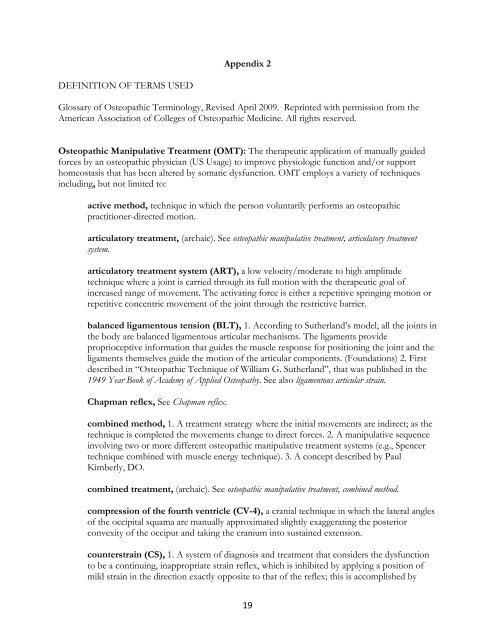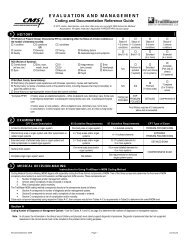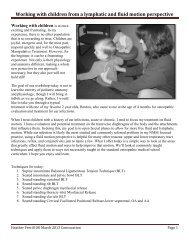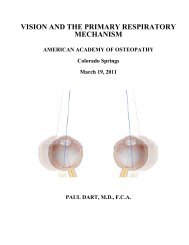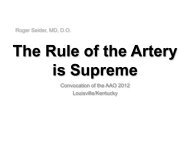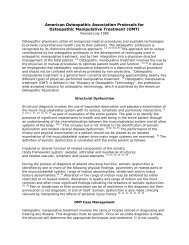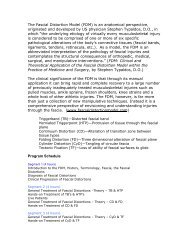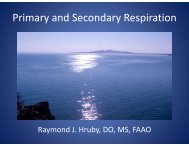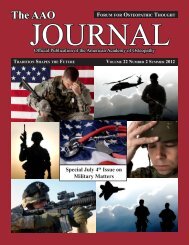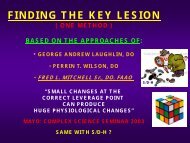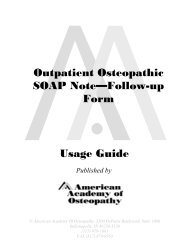(OMT) for Patients with Low Back Pain - American Academy of ...
(OMT) for Patients with Low Back Pain - American Academy of ...
(OMT) for Patients with Low Back Pain - American Academy of ...
Create successful ePaper yourself
Turn your PDF publications into a flip-book with our unique Google optimized e-Paper software.
Appendix 2DEFINITION OF TERMS USEDGlossary <strong>of</strong> Osteopathic Terminology, Revised April 2009. Reprinted <strong>with</strong> permission from the<strong>American</strong> Association <strong>of</strong> Colleges <strong>of</strong> Osteopathic Medicine. All rights reserved.Osteopathic Manipulative Treatment (<strong>OMT</strong>): The therapeutic application <strong>of</strong> manually guided<strong>for</strong>ces by an osteopathic physician (US Usage) to improve physiologic function and/or supporthomeostasis that has been altered by somatic dysfunction. <strong>OMT</strong> employs a variety <strong>of</strong> techniquesincluding, but not limited to:active method, technique in which the person voluntarily per<strong>for</strong>ms an osteopathicpractitioner-directed motion.articulatory treatment, (archaic). See osteopathic manipulative treatment, articulatory treatmentsystem.articulatory treatment system (ART), a low velocity/moderate to high amplitudetechnique where a joint is carried through its full motion <strong>with</strong> the therapeutic goal <strong>of</strong>increased range <strong>of</strong> movement. The activating <strong>for</strong>ce is either a repetitive springing motion orrepetitive concentric movement <strong>of</strong> the joint through the restrictive barrier.balanced ligamentous tension (BLT), 1. According to Sutherland’s model, all the joints inthe body are balanced ligamentous articular mechanisms. The ligaments provideproprioceptive in<strong>for</strong>mation that guides the muscle response <strong>for</strong> positioning the joint and theligaments themselves guide the motion <strong>of</strong> the articular components. (Foundations) 2. Firstdescribed in “Osteopathic Technique <strong>of</strong> William G. Sutherland”, that was published in the1949 Year Book <strong>of</strong> <strong>Academy</strong> <strong>of</strong> Applied Osteopathy. See also ligamentous articular strain.Chapman reflex, See Chapman reflex.combined method, 1. A treatment strategy where the initial movements are indirect; as thetechnique is completed the movements change to direct <strong>for</strong>ces. 2. A manipulative sequenceinvolving two or more different osteopathic manipulative treatment systems (e.g., Spencertechnique combined <strong>with</strong> muscle energy technique). 3. A concept described by PaulKimberly, DO.combined treatment, (archaic). See osteopathic manipulative treatment, combined method.compression <strong>of</strong> the fourth ventricle (CV-4), a cranial technique in which the lateral angles<strong>of</strong> the occipital squama are manually approximated slightly exaggerating the posteriorconvexity <strong>of</strong> the occiput and taking the cranium into sustained extension.counterstrain (CS), 1. A system <strong>of</strong> diagnosis and treatment that considers the dysfunctionto be a continuing, inappropriate strain reflex, which is inhibited by applying a position <strong>of</strong>mild strain in the direction exactly opposite to that <strong>of</strong> the reflex; this is accomplished by19


